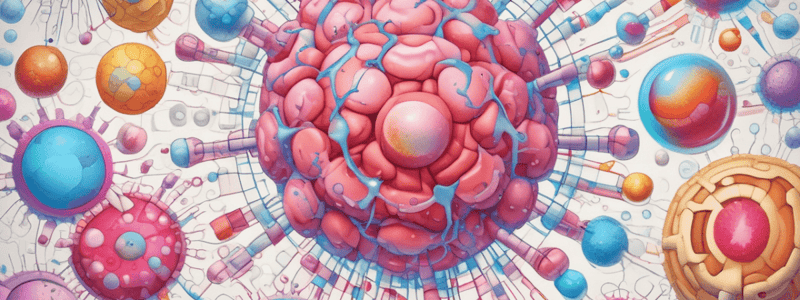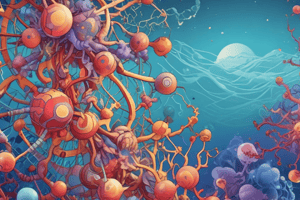Podcast
Questions and Answers
What type of virus is HIV considered to be?
What type of virus is HIV considered to be?
- Adenovirus
- DNA virus
- RNA virus
- Retrovirus (correct)
Which type of HIV is mainly found in Western Africa?
Which type of HIV is mainly found in Western Africa?
- HIV subtypes
- HIV M group
- HIV 1
- HIV 2 (correct)
What is the primary enzyme targeted by Nucleoside Reverse Transcriptase Inhibitors (NRTIs)?
What is the primary enzyme targeted by Nucleoside Reverse Transcriptase Inhibitors (NRTIs)?
- RNA polymerase
- DNA polymerase
- Protease enzyme
- Reverse transcriptase (correct)
Which antiviral agent specifically inhibits the HIV protease enzyme?
Which antiviral agent specifically inhibits the HIV protease enzyme?
Why are some HIV-1 M group subtypes considered to be more virulent?
Why are some HIV-1 M group subtypes considered to be more virulent?
What characteristic of RNA viruses makes them prone to rapid mutation?
What characteristic of RNA viruses makes them prone to rapid mutation?
Which of the following sources provides information on approved antiviral drugs over the past 50 years?
Which of the following sources provides information on approved antiviral drugs over the past 50 years?
Which edition of 'An Introduction to Medicinal Chemistry' by Graham Patrick is referenced in the text?
Which edition of 'An Introduction to Medicinal Chemistry' by Graham Patrick is referenced in the text?
Which chapter of 'Foye’s Principles of Medicinal Chemistry' discusses the conventional nucleoside analogues?
Which chapter of 'Foye’s Principles of Medicinal Chemistry' discusses the conventional nucleoside analogues?
Which of the following is not a class of therapeutic agents used in the treatment of HIV?
Which of the following is not a class of therapeutic agents used in the treatment of HIV?
Which of the following sources provides information on the strategies employed for the development of newer generations of antiviral drugs?
Which of the following sources provides information on the strategies employed for the development of newer generations of antiviral drugs?
Which of the following sources provides information on the acyclic nucleoside analogues?
Which of the following sources provides information on the acyclic nucleoside analogues?
Why is it recommended to take 2-3 drugs of different classes to minimize the risk of resistance?
Why is it recommended to take 2-3 drugs of different classes to minimize the risk of resistance?
What is the probability of developing resistance when taking three different drugs with a mutation chance of 1:10,000 each?
What is the probability of developing resistance when taking three different drugs with a mutation chance of 1:10,000 each?
Which component of HIV treatment aims to avoid resistance despite ongoing mutation risks?
Which component of HIV treatment aims to avoid resistance despite ongoing mutation risks?
What is the primary reason for patients needing to take HAART for the rest of their lives?
What is the primary reason for patients needing to take HAART for the rest of their lives?
What is the main advantage of combining multiple drugs into a single HAART pill?
What is the main advantage of combining multiple drugs into a single HAART pill?
Which class of drugs is referred to as nucleoside analogues and requires triphosphate activation to be effective?
Which class of drugs is referred to as nucleoside analogues and requires triphosphate activation to be effective?
Which type of drug is Zidovudine (AZT)?
Which type of drug is Zidovudine (AZT)?
What is the unique characteristic of the enzyme reverse transcriptase that makes it an ideal target for HIV drugs?
What is the unique characteristic of the enzyme reverse transcriptase that makes it an ideal target for HIV drugs?
Which drug was the second HIV drug approved in the USA in 1988?
Which drug was the second HIV drug approved in the USA in 1988?
How do nucleoside reverse transcriptase inhibitors (NRTIs) need to be activated to be effective against HIV?
How do nucleoside reverse transcriptase inhibitors (NRTIs) need to be activated to be effective against HIV?
What is the role of Zalcitabine in HIV treatment?
What is the role of Zalcitabine in HIV treatment?
Which process do Integrase inhibitors target in the HIV life cycle?
Which process do Integrase inhibitors target in the HIV life cycle?
Why do nucleoside reverse transcriptase inhibitors (NRTIs) need to ensure selectivity despite targeting reverse transcriptase?
Why do nucleoside reverse transcriptase inhibitors (NRTIs) need to ensure selectivity despite targeting reverse transcriptase?
Which drug is an adenosine analogue used against HIV and/or Hepatitis B?
Which drug is an adenosine analogue used against HIV and/or Hepatitis B?
What is the main difference between Adefovir and Tenofovir?
What is the main difference between Adefovir and Tenofovir?
What is the role of gp41 in the adsorption and penetration process of HIV?
What is the role of gp41 in the adsorption and penetration process of HIV?
What is the function of the viral protein integrase in the life cycle of HIV?
What is the function of the viral protein integrase in the life cycle of HIV?
What is the significance of the (+)vRNA/(-)vDNA hybrid in the replication of HIV genome?
What is the significance of the (+)vRNA/(-)vDNA hybrid in the replication of HIV genome?
Which viral enzymes have been identified as possible targets for developing therapeutics against HIV?
Which viral enzymes have been identified as possible targets for developing therapeutics against HIV?
What is the role of the viral protein Vpu in the budding process of HIV?
What is the role of the viral protein Vpu in the budding process of HIV?
What is the purpose of pre-exposure prophylaxis (PrEP) in the prevention of HIV transmission?
What is the purpose of pre-exposure prophylaxis (PrEP) in the prevention of HIV transmission?
What is the time frame for post-exposure prophylaxis (PEP) to be effective in preventing HIV transmission after exposure?
What is the time frame for post-exposure prophylaxis (PEP) to be effective in preventing HIV transmission after exposure?
Which viral proteins are involved in the capsid structure of HIV?
Which viral proteins are involved in the capsid structure of HIV?
What is the role of CD4 proteins on host T-cells in the adsorption and penetration process of HIV?
What is the role of CD4 proteins on host T-cells in the adsorption and penetration process of HIV?
How does the viral enzyme reverse transcriptase contribute to the replication of the HIV genome?
How does the viral enzyme reverse transcriptase contribute to the replication of the HIV genome?
What were the desirable features of Protease Inhibitors (PIs) according to the text?
What were the desirable features of Protease Inhibitors (PIs) according to the text?
Which compound was the most recent protease inhibitor to enter the market according to the text?
Which compound was the most recent protease inhibitor to enter the market according to the text?
What disadvantage is associated with Saquinavir as mentioned in the text?
What disadvantage is associated with Saquinavir as mentioned in the text?
What was the strategy employed in the design of Ritonavir (1st generation) and Lopinavir (2nd generation) protease inhibitors?
What was the strategy employed in the design of Ritonavir (1st generation) and Lopinavir (2nd generation) protease inhibitors?
What was the aim of simplification in the drug design process for Saquinavir?
What was the aim of simplification in the drug design process for Saquinavir?
Which compound was designed using a hybridization strategy with saquinavir as half of the lead?
Which compound was designed using a hybridization strategy with saquinavir as half of the lead?
What factor was considered in subsequent research on modern protease inhibitors to reduce from precursor analogues?
What factor was considered in subsequent research on modern protease inhibitors to reduce from precursor analogues?
What is the primary mechanism of action of non-nucleoside reverse transcriptase inhibitors (NNRTIs)?
What is the primary mechanism of action of non-nucleoside reverse transcriptase inhibitors (NNRTIs)?
Which of the following is a common issue with first-generation NNRTIs?
Which of the following is a common issue with first-generation NNRTIs?
Which of the following is a characteristic of second-generation NNRTIs?
Which of the following is a characteristic of second-generation NNRTIs?
Which of the following is a difference between NNRTIs and protease inhibitors (PIs)?
Which of the following is a difference between NNRTIs and protease inhibitors (PIs)?
Which of the following is a characteristic of the precursor polyproteins for HIV?
Which of the following is a characteristic of the precursor polyproteins for HIV?
Which of the following is a common issue with peptide-based HIV drugs?
Which of the following is a common issue with peptide-based HIV drugs?
Which of the following is a difference between first-generation and second-generation NNRTIs?
Which of the following is a difference between first-generation and second-generation NNRTIs?
Which of the following is a characteristic of Efavirenz, Etravirine, and Rilpivirine?
Which of the following is a characteristic of Efavirenz, Etravirine, and Rilpivirine?
Which of the following is a difference between NNRTIs and nucleoside reverse transcriptase inhibitors (NRTIs)?
Which of the following is a difference between NNRTIs and nucleoside reverse transcriptase inhibitors (NRTIs)?
Which of the following is a characteristic of protease inhibitors (PIs)?
Which of the following is a characteristic of protease inhibitors (PIs)?
What is the function of the viral protein Vpu in the HIV life cycle?
What is the function of the viral protein Vpu in the HIV life cycle?
What is a unique characteristic of the HIV protease enzyme that differs from mammalian proteases?
What is a unique characteristic of the HIV protease enzyme that differs from mammalian proteases?
Which amino acid residues in the HIV protease enzyme monomers are crucial to the reaction mechanism?
Which amino acid residues in the HIV protease enzyme monomers are crucial to the reaction mechanism?
What is the primary function of HIV protease inhibitors?
What is the primary function of HIV protease inhibitors?
Which type of tetrahedral intermediate is involved in the reaction mechanism of the HIV protease enzyme?
Which type of tetrahedral intermediate is involved in the reaction mechanism of the HIV protease enzyme?
Which of the following is a common feature of HIV protease inhibitors and renin inhibitors?
Which of the following is a common feature of HIV protease inhibitors and renin inhibitors?
What is the primary purpose of introducing a stable tetrahedral feature in the design of HIV protease inhibitors?
What is the primary purpose of introducing a stable tetrahedral feature in the design of HIV protease inhibitors?
What is the role of the hydroxyethylamine isostere in the design of HIV protease inhibitors?
What is the role of the hydroxyethylamine isostere in the design of HIV protease inhibitors?
Which of the following best describes the substrate binding and cleavage process in the HIV protease enzyme?
Which of the following best describes the substrate binding and cleavage process in the HIV protease enzyme?
Which of the following statements best describes the similarities between the two variants of HIV protease (HIV-1 and HIV-2)?
Which of the following statements best describes the similarities between the two variants of HIV protease (HIV-1 and HIV-2)?
Flashcards are hidden until you start studying
Study Notes
HIV and AIDS
- HIV (Human Immunodeficiency Virus) is a type of retrovirus that causes AIDS (Acquired Immune Deficiency Syndrome)
- AIDS is a condition where the immune system is severely weakened, making the body susceptible to opportunistic infections and cancers
- HIV infects T-cells of the immune system, which are vital for fighting infections
Life Cycle of HIV
- HIV life cycle involves seven stages: binding, fusion, reverse transcription, integration, replication, assembly, and budding
- HIV uses its reverse transcriptase enzyme to convert its RNA genome into DNA, which is then integrated into the host cell's genome
- The integrated DNA is transcribed into mRNA, which is translated into HIV proteins
- The proteins are assembled into new viral particles, which bud from the host cell
Anti-HIV Therapies
- Antiretroviral therapy (ART) is a combination of drugs that target different stages of the HIV life cycle
- Types of HIV therapies:
- Nucleoside reverse transcriptase inhibitors (NRTIs)
- Non-nucleoside reverse transcriptase inhibitors (NNRTIs)
- Protease inhibitors (PIs)
- Fusion inhibitors
- Integrase inhibitors
Nucleoside Reverse Transcriptase Inhibitors (NRTIs)
- NRTIs are nucleoside analogs that inhibit the action of HIV reverse transcriptase
- Examples of NRTIs:
- Zidovudine (AZT)
- Didanosine (DdI)
- Lamivudine (3TC)
- Emtricitabine (FTC)
- Abacavir (ABC)
- NRTIs need to be triphosphorylated to be active
- They inhibit reverse transcriptase and act as chain terminators
Non-Nucleoside Reverse Transcriptase Inhibitors (NNRTIs)
- NNRTIs bind to an allosteric site of reverse transcriptase, causing a conformational change that inhibits the enzyme
- Examples of NNRTIs:
- Nevirapine
- Delavirdine
- Efavirenz
- Rilpivirine
- NNRTIs are non-competitive, reversible inhibitors
Protease Inhibitors (PIs)
- PIs inhibit the action of HIV protease, which is essential for the production of mature viral particles
- Examples of PIs:
- Saquinavir
- Ritonavir
- Indinavir
- Nelfinavir
- Amprenavir
- PIs are designed to have low peptidic character to improve oral bioavailability
HAART (Highly Active Antiretroviral Therapy)
- HAART is a combination of three or more antiretroviral drugs, including NRTIs, NNRTIs, and PIs
- HAART reduces the viral load, increases CD4+ cell count, and improves survival
- HAART is a lifelong treatment, and adherence to the regimen is crucial to prevent resistance and treatment failure### Stereochemistry and HIV-Protease Inhibitors
- The P1' position is crucial in HIV-protease inhibitors due to stereochemistry considerations.
- Initial inhibitors were based on peptides, but they had high molecular weight, poor oral bioavailability, and were prone to mutation.
Design of HIV-Protease Inhibitors
- The design focused on the S1-S1' region, then extended to interact with S2/S3 and S2'/S3' sites.
- Desirable features of protease inhibitors (PIs) include:
- Low molecular weight
- Good oral bioavailability
- Good water solubility
- Selective for viral protease
- Activity unaltered by mutation of viral protease
First-Generation Protease Inhibitors
- Saquinavir (1995) was the first protease inhibitor used clinically.
- It was designed from a peptide lead compound, but had high molecular weight, poor oral bioavailability, and was prone to drug resistance.
Saquinavir Development
- The lead compound was developed from a pentapeptide sequence containing the susceptible Phe-Pro linkage.
- The design involved introducing a transition-state isostere, adding Asn to make it more peptidic, optimizing the N-terminus, and optimizing the C-terminus.
- This resulted in a 40-fold, 8-fold, and 60-fold increase in activity, respectively.
Saquinavir Binding Interactions
- Five subsites (S3-S2') are occupied, with the transition state isostere interacting with the catalytic aspartates.
- Carbonyls act as hydrogen bond acceptors to the bridging water molecule in the flap region.
Tipranavir
- It was designed from a non-peptide lead compound, using high-throughput screening of 5000 compounds.
- The design involved multiple synthetic and optimization steps, resulting in a compound with increased metabolic stability.
- Tipranavir has a Ki of 8 pM and an IC50 of 30 nM.
Other Protease Inhibitors
- Ritonavir (1996) and Indinavir (1996) were designed using a hybridization strategy.
- Nelfinavir (1997) and Amprenavir (1999) were designed using a non-peptide-like approach, using saquinavir as a lead compound.
- Darunavir and Atazanavir (2003) were designed using a combination of approaches.
- Lopinavir and Tipranavir are the most recent protease inhibitors to market.
Protease Inhibitors Summary
- Protease inhibitors can be designed from non-peptidic or peptidic lead compounds.
- Key features include:
- Transition state isostere
- Maximizing interaction with subsites in the receptor
- Keeping the molecular weight small
- Improving solubility
- Using bioisosteres
- Avoiding mutation issues
- Improving metabolic stability
HIV Life Cycle
- The HIV protease enzyme is involved in the viral life cycle, cleaving peptide bonds and releasing the virion.
- The enzyme has broad substrate specificity, but can be inhibited by protease inhibitors.
HIV Protease Enzyme
- The enzyme is a symmetrical dimer, composed of two identical protein units.
- The active site is located at the interface between the two protein units, with two fold rotational symmetry.
- The enzyme has broad substrate specificity, but can be inhibited by protease inhibitors.
HIV Protease Inhibitors in HAART Treatment
- HIV protease inhibitors are used in combination with other antiretroviral drugs in HAART (Highly Active Antiretroviral Therapy) treatment.
- The treatment has been successful in reducing the viral load and improving the quality of life for HIV patients.
Studying That Suits You
Use AI to generate personalized quizzes and flashcards to suit your learning preferences.




